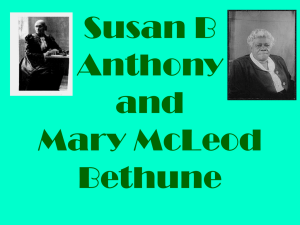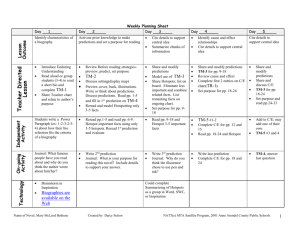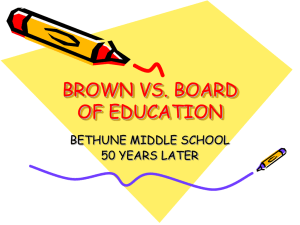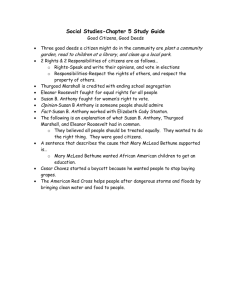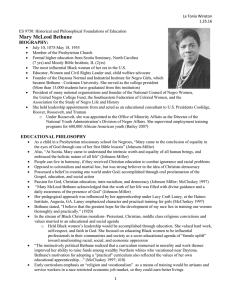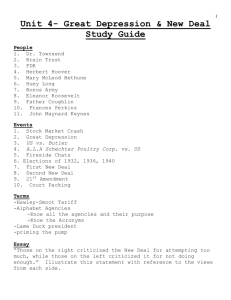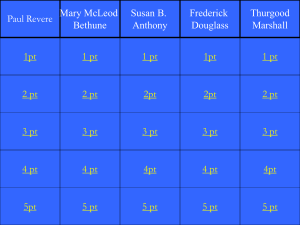Lesson Plans: 03 SS LPQ2 Mary McLeod Bethune and Character
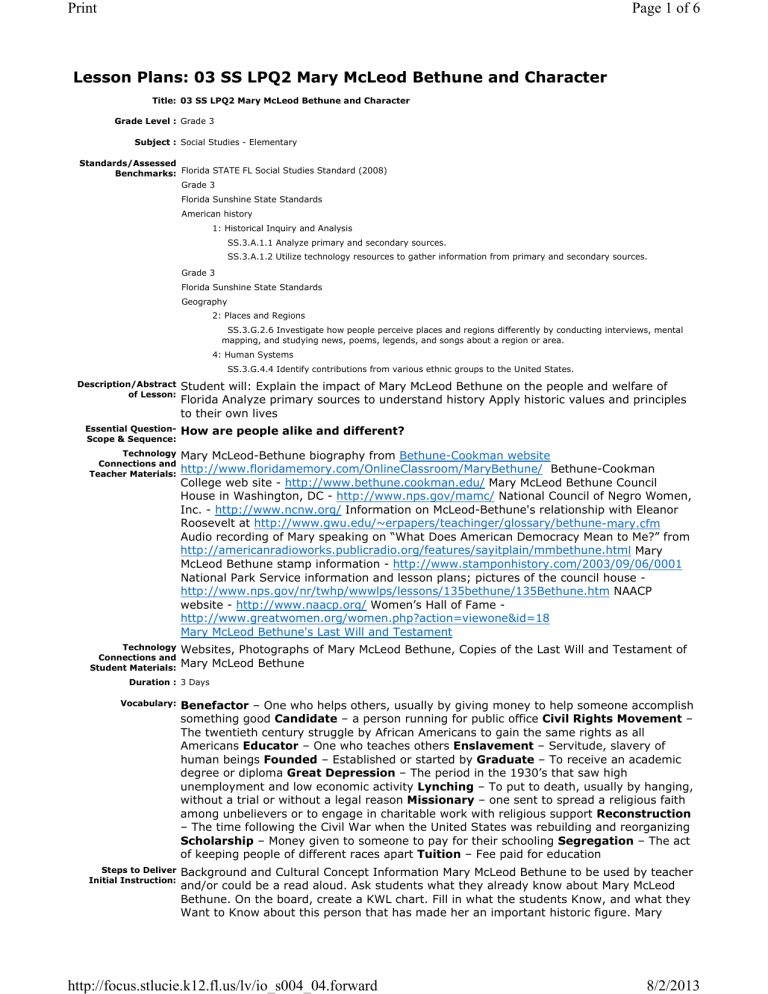
Print Page 1 of 6
Lesson Plans: 03 SS LPQ2 Mary McLeod Bethune and Character
Title: 03 SS LPQ2 Mary McLeod Bethune and Character
Grade Level : Grade 3
Subject : Social Studies - Elementary
Standards/Assessed
Benchmarks:
Florida STATE FL Social Studies Standard (2008)
Grade 3
Florida Sunshine State Standards
American history
1: Historical Inquiry and Analysis
SS.3.A.1.1 Analyze primary and secondary sources.
SS.3.A.1.2 Utilize technology resources to gather information from primary and secondary sources.
Grade 3
Florida Sunshine State Standards
Geography
2: Places and Regions
SS.3.G.2.6 Investigate how people perceive places and regions differently by conducting interviews, mental mapping, and studying news, poems, legends, and songs about a region or area.
4: Human Systems
SS.3.G.4.4 Identify contributions from various ethnic groups to the United States.
Description/Abstract of Lesson:
Student will: Explain the impact of Mary McLeod Bethune on the people and welfare of
Florida Analyze primary sources to understand history Apply historic values and principles to their own lives
How are people alike and different?
Essential Question-
Scope & Sequence:
Technology
Connections and
Teacher Materials:
Mary McLeod-Bethune biography from Bethune-Cookman website http://www.floridamemory.com/OnlineClassroom/MaryBethune/ Bethune-Cookman
College web site http://www.bethune.cookman.edu/ Mary McLeod Bethune Council
House in Washington, DC http://www.nps.gov/mamc/ National Council of Negro Women,
Inc. http://www.ncnw.org/ Information on McLeod-Bethune's relationship with Eleanor
Roosevelt at http://www.gwu.edu/~erpapers/teachinger/glossary/bethune-mary.cfm
Audio recording of Mary speaking on “What Does American Democracy Mean to Me?” from http://americanradioworks.publicradio.org/features/sayitplain/mmbethune.html
Mary
McLeod Bethune stamp information http://www.stamponhistory.com/2003/09/06/0001
National Park Service information and lesson plans; pictures of the council house http://www.nps.gov/nr/twhp/wwwlps/lessons/135bethune/135Bethune.htm
NAACP website http://www.naacp.org/ Women’s Hall of Fame http://www.greatwomen.org/women.php?action=viewone&id=18
Mary McLeod Bethune's Last Will and Testament
Technology
Connections and
Student Materials:
Websites, Photographs of Mary McLeod Bethune, Copies of the Last Will and Testament of
Mary McLeod Bethune
Duration : 3 Days
Vocabulary: Benefactor – One who helps others, usually by giving money to help someone accomplish something good Candidate – a person running for public office Civil Rights Movement –
The twentieth century struggle by African Americans to gain the same rights as all
Americans Educator – One who teaches others Enslavement – Servitude, slavery of human beings Founded – Established or started by Graduate – To receive an academic degree or diploma Great Depression – The period in the 1930’s that saw high unemployment and low economic activity Lynching – To put to death, usually by hanging, without a trial or without a legal reason Missionary – one sent to spread a religious faith among unbelievers or to engage in charitable work with religious support Reconstruction
– The time following the Civil War when the United States was rebuilding and reorganizing
Scholarship – Money given to someone to pay for their schooling Segregation – The act of keeping people of different races apart Tuition – Fee paid for education
Steps to Deliver
Initial Instruction:
Background and Cultural Concept Information Mary McLeod Bethune to be used by teacher and/or could be a read aloud. Ask students what they already know about Mary McLeod
Bethune. On the board, create a KWL chart. Fill in what the students Know, and what they
Want to Know about this person that has made her an important historic figure. Mary http://focus.stlucie.k12.fl.us/lv/io_s004_04.forward
8/2/2013
Print Page 2 of 6
McLeod Bethune (1875-1955), an African American teacher, was one of the great educators of the United States. She was a leader of women, a distinguished adviser to several American presidents, and a powerful champion of racial equality. Mary McLeod was born in Mayesville, S.C. Her parents, Samuel and Patsy McLeod, were former slaves; Mary was the fifteenth of 17 children. She helped her parents on the family farm and first entered a Presbyterian mission school when she was 11 years old. Later she attended
Scotia Seminary, a school for African American girls in Concord, N.C., on a scholarship.
She graduated in 1893; there she had met some of the people with whom she would work closely. Though she had a serious turn of mind, it did not prevent her from being a lively dancer and developing a lasting fondness for music. Dynamic and alert, she was very popular and the acknowledged leader of her classmates. After graduating from Scotia
Seminary, she attended the Moody Bible Institute. Career as an Educator. After graduation from Moody Institute, she wished to become a missionary in Africa. However, she was unable to pursue this end. She was an instructor at the Presbyterian Mission School in
Mayesville in 1896 and later an instructor at Haines Institute in Augusta, Ga., in 1896-
1897. While she was an instructor at Kindell Institute in Sumpter, S.C., in 1897-1898, she met Albertus Bethune, whom she later married. Bethune began her career as an educator in earnest when she rented a two-story frame building in Daytona Beach, Fla., and began the difficult task of establishing a school for African American girls. Her school opened in
October 1904, with six pupils, five girls and her own son; there was no equipment; crates were used for desks and charcoal took the place of pencils; and ink came from crushed elderberries. Thus began the Daytona Literary and Industrial School for Training Negro
Girls, in an era when most African American children received little or no education. At first
Bethune was teacher, administrator, comptroller, and custodian. Later she was able to secure a staff, many of whom worked loyally for many years. To finance and expand the school, Bethune and her pupils baked pies and made ice cream to sell to nearby construction gangs. In addition to her regular classes, Bethune organized classes for the children of turpentine workers. In these ways she satisfied her desire to serve as a missionary. As the school at Daytona progressed, it became necessary to secure an adequate financial base. Bethune began to seek financial aid in earnest. In 1912 she interested James M. Gamble of the Proctor and Gamble Company of Cincinnati, Ohio, who contributed financially to the school and served as chairman of its board of trustees until his death. In 1923 Bethune's school for girls merged with Cookman Institute of
Jacksonville, Fla., a school for boys, and the new coeducational school became known as
Bethune-Cookman Collegiate Institute, soon renamed Bethune-Cookman College. Bethune served as president of the college until her retirement as president emeritus in 1942. She remained a trustee of the college to the end of her life. By 1955 the college had a faculty of 100 and a student enrollment of over 1,000. Bethune's business activities were confined to the Central Life Insurance Company of Tampa, Fla., of which she was president for several years; the Afro-American Life Insurance Company of Jacksonville, which she served as director; and the Bethune-Volusia Beach Corporation, a recreation area and housing development she founded in 1940. In addition, she wrote numerous magazine and newspaper articles and contributed chapters to several books. In 1932 she founded and organized the National Council of Negro Women and became its president; by 1955 this organization had a membership of 800,000. Bethune gained national recognition in 1936, when President Franklin D. Roosevelt appointed her director of African American affairs in the National Youth Administration and a special adviser on minority affairs. She served for
8 years and supervised the expansion of employment opportunities and recreational facilities for African American youth throughout the United States. She also served as special assistant to the secretary of war during World War II. In the course of her government assignments she became a close friend of Eleanor Roosevelt. During her long career Bethune received many honorary degrees and awards, including the Haitian Medal of Honor and Merit (1949), the highest award of the Haitian government. Bethune died in
Daytona Beach on May 18, 1955, of a heart attack. She was buried on the campus of
Bethune-Cookman College. For a more detailed biography, http://www.bethune.cookman.edu/about_BCU/history/our_founder.html
Guided Practice with
Feedback:
Independent
Practice:
Following the read aloud of the introductory essay, each student should write one paragraph describing Mary McLeod Bethune's greatest accomplishment with supporting details. Students should be directed to decide on their own and to provide at least one reason for their selection. z
Use a projector to show the picture of Mary McLeod-Bethune speaking at the dedication of the Council of Negro Women House in Washington, DC. Discuss http://focus.stlucie.k12.fl.us/lv/io_s004_04.forward
8/2/2013
Print Page 3 of 6 z z students’ observations, using Teaching with Historical Places questions as a guide.
{
Examine the photograph for 10 seconds. How would you describe the photograph?
What details – such as people, objects, activities – do you notice?
What other information – such as time period, location, season, reason photo was taken – can you gather from the photo?
What questions do you have about this photograph?
{
Of whom and where do you think this picture was taken?
This picture shows Mary McLeod Bethune (with back to camera) speaking at
{ the National Council of Negro Women House dedication, October 15, 1944.
Check students’ observations and predictions.
Show the photo (see attachmed file below) taken of Eleanor Roosevelt speaking at the dedication.
Analyze the picture using these questions:
{
Why do you think Eleanor Roosevelt was there at the dedication of the National
Council of Negro Women House?
{
{
What might Eleanor Roosevelt be saying?
Who else might be in the picture?
z
Use a projector to show the following map of Washington, D.C. The star indicates the location of the National Council of Negro Women House. Optional: distribute individual copies of the map http://www.nps.gov/nr//twhp/wwwlps/lessons/135bethune/135visuals/135map1ch.jpg> z z z z
Discuss the following questions: Note the location of the house in relationship to the
White House.
{
{
{
How would this have benefited the organization?
How did the makeup of Logan Circle change over time?
Why do you think Mary McLeod Bethune chose this location for the headquarters?
{
This map is missing a compass rose. Compare the map to a current map of
Washington, D.C. http://www.mapquest.com/ and identify north, south, east, and west.
What do you notice about how the streets are named (letters and numbers)?
How would that help a newcomer in navigating Washington, D.C.?
As a class, compose directions to get from the NCNW house (1318 Vermont Avenue) to the White House.
Pass out copies of the Washington, DC map. In pairs, students write directions to get from Dupont Circle to the NCNW house. They also pick two other locations and write directions to get from those locations to the council house.
{
Each group presents their directions orally to the class, while tracing the path
{ on the projection.
As a lesson closure, review the KWL chart created at the beginning of the lesson. Fill in what the students have Learned.
{
This map shows the location of Mary McLeod Bethune Council House National
Historic Site (denoted by star). At the time of its construction in the mid
1870s, the townhouse that later became the first headquarters of the National
Council of Negro Women was situated in a fashionable residential D.C. neighborhood. By the latter part of the 19th century, this area—eventually known as Logan Circle in honor of Civil War Union General John Logan—had become a popular neighborhood for white upper middle-class businessmen and politicians as the capital city grew. At the end of the century, however, these wealthy homeowners began to relocate toward nearby Dupont Circle. At the same time, more and more African Americans began moving into the Logan
Circle area and other neighborhoods to the north, particularly along U Street between 7th and 16th Streets. By 1920, this entire area had become the center of African American life in the segregated capital city. The U Street corridor featured a large number of businesses and entertainment facilities owned by African Americans, and the surrounding neighborhoods became home to many of the city's most prominent black citizens. When Bethune purchased the Vermont Avenue house in 1943 on behalf of NCNW, neighbors included African American attorneys, ministers, and a doctor.
http://focus.stlucie.k12.fl.us/lv/io_s004_04.forward
8/2/2013
Print Page 4 of 6
Differentiated
Instruction/Small
Groups: z
Divide class into 3 groups. Each group should contain students of all ability levels.
Distribute copies of Mary McLeod Bethune’s last will and testament.
{
{
Read the introductory paragraph aloud to the class.
Have each group read three of the sections of the will.
Group 1: I leave you love, I leave you hope, I leave you the challenge of developing confidence in one another
Group 2: I leave you a thirst for education, I leave you respect for the uses of power, I leave you faith
Group 3: I leave you racial dignity, I leave you a desire to live harmoniously with your fellow men, I leave you a responsibility to our young people
{
Each group reads their sections together and answers the following questions:
How did Mary McLeod Bethune embody these values?
What actions did she take to demonstrate her beliefs in these principles?
Does today’s society reflect these principles? Which principles still need attention?
My Last Will and Testament by Mary McLeod Bethune Sometimes as I sit communing in my study I feel that death is not far off. I am aware that it will overtake me before the greatest of my dreams – full equality for the Negro in our time – is realized. Yet, I face that reality without fear or regrets. I am resigned to death as all humans must be at the proper time. Death neither alarms nor frightens one who has had a long career of fruitful toil. The knowledge that my work has been helpful to many fills me with joy and great satisfaction. Since my retirement from an active role in educational work and from the affairs of the National Council of Negro
Women, I have been living quietly and working at my desk at my home here in
Florida. The years have directed a change of pace for me. I am now 78 years old and my activities are no longer so strenuous as they once were. I feel that I must conserve my strength to finish the work at hand. Already I have begun working on my autobiography which will record my life-journey in detail, together with the innumerable side trips which have carried me abroad, into every corner of our country, into homes both lowly and luxurious, and even into the White House to confer with Presidents. I have also deeded my home and its contents to the Mary
McLeod Bethune Foundation, organized in March, 1953, for research, interracial activity and the sponsorship of wider educational opportunities. Sometimes I ask myself if I have any other legacy to leave. Truly, my worldly possessions are few.
Yet, my experiences have been rich. From them, I have distilled principles and policies in which I believe firmly, for they represent the meaning of my life's work.
They are the products of much sweat and sorrow. Perhaps in them there is something of value. So, as my life draws to a close, I will pass them on to Negroes everywhere in the hope that an old woman's philosophy may give them inspiration.
Here, then is my legacy. I LEAVE YOU LOVE. Love builds. It is positive and helpful. It is more beneficial than hate. Injuries quickly forgotten quickly pass away. Personally and racially, our enemies must be forgiven. Our aim must be to create a world of fellowship and justice where no man's skin, color or religion, is held against him.
"Love thy neighbor" is a precept which could transform the world if it were universally practiced. It connotes brotherhood and, to me, brotherhood of man is the noblest concept in all human relations. Loving your neighbor means being interracial, interreligious and international. I LEAVE YOU HOPE. The Negro's growth will be great in the years to come. Yesterday, our ancestors endured the degradation of slavery, yet they retained their dignity. Today, we direct our economic and political strength toward winning a more abundant and secure life. Tomorrow, a new Negro, unhindered by race taboos and shackles, will benefit from more than 330 years of ceaseless striving and struggle. Theirs will be a better world. This I believe with all my heart. I LEAVE YOU THE CHALLENGE OF DEVELOPING CONFIDENCE IN ONE
ANOTHER. As long as Negroes are hemmed into racial blocs by prejudice and pressure, it will be necessary for them to band together for economic betterment.
Negro banks, insurance companies and other businesses are examples of successful, racial economic enterprises. These institutions were made possible by vision and mutual aid. Confidence was vital in getting them started and keeping them going.
Negroes have got to demonstrate still more confidence in each other in business.
This kind of confidence will aid the economic rise of the race by bringing together the http://focus.stlucie.k12.fl.us/lv/io_s004_04.forward
8/2/2013
Print Page 5 of 6 pennies and dollars of our people and ploughing them into useful channels. Economic separatism cannot be tolerated in this enlightened age, and it is not practicable. We must spread out as far and as fast as we can, but we must also help each other as we go. I LEAVE YOU A THIRST FOR EDUCATION. Knowledge is the prime need of the hour. More and more, Negroes are taking full advantage of hard-won opportunities for learning, and the educational level of the Negro population is at its highest point in history. We are making greater use of the privileges inherent in living in a democracy. If we continue in this trend, we will be able to rear increasing numbers of strong, purposeful men and women, equipped with vision, mental clarity, health and education. I LEAVE YOU RESPECT FOR THE USES OF POWER. We live in a world which respects power above all things. Power, intelligently directed, can lead to more freedom. Unwisely directed, it can be a dreadful, destructive force. During my lifetime I have seen the power of the Negro grow enormously. It has always been my first concern that this power should be placed on the side of human justice. Now that the barriers are crumbling everywhere, the Negro in America must be ever vigilant lest his forces be marshalled behind wrong causes and undemocratic movements. He must not lend his support to any group that seeks to subvert democracy. That is why we must select leaders who are wise, courageous, and of great moral stature and ability. We have great leaders among us today: Ralph
Bunche, Channing Tobias, Mordecai Johnson, Walter White, and Mary Church Terrell.
[The latter now deceased]. We have had other great men and women in the past:
Frederick Douglass, Booker T. Washington, Harriet Tubman, and Sojourner Truth.
We must produce more qualified people like them, who will work not for themselves, but for others. I LEAVE YOU FAITH. Faith is the first factor in a life devoted to service. Without faith, nothing is possible. With it, nothing is impossible. Faith in God is the greatest power, but great, too, is faith in oneself. In 50 years the faith of the
American Negro in himself has grown immensely and is still increasing. The measure of our progress as a race is in precise relation to the depth of the faith in our people held by our leaders. Frederick Douglass, genius though he was, was spurred by a deep conviction that his people would heed his counsel and follow him to freedom.
Our greatest Negro figures have been imbued with faith. Our forefathers struggled for liberty in conditions far more onerous than those we now face, but they never lost the faith. Their perseverance paid rich dividends. We must never forget their sufferings and their sacrifices, for they were the foundations of the progress of our people. I LEAVE YOU RACIAL DIGNITY. I want Negroes to maintain their human dignity at all costs. We, as Negroes, must recognize that we are the custodians as well as the heirs of a great civilization. We have given something to the world as a race and for this we are proud and fully conscious of our place in the total picture of mankind's development. We must learn also to share and mix with all men. We must make and effort to be less race conscious and more conscious of individual and human values. I have never been sensitive about my complexion. My color has never destroyed my self-respect nor has it ever caused me to conduct myself in such a manner as to merit the disrespect of any person. I have not let my color handicap me. Despite many crushing burdens and handicaps, I have risen from the cotton fields of South Carolina to found a college, administer it during its years of growth, become a public servant in the government of our country and a leader of women. I would not exchange my color for all the wealth in the world, for had I been born white I might not have been able to do all that I have done or yet hope to do. I
LEAVE YOU A DESIRE TO LIVE HARMONIOUSLY WITH YOUR FELLOW MEN. The problem of color is worldwide. It is found in Africa and Asia, Europe and South
America. I appeal to American Negroes -- North, South, East and West -- to recognize their common problems and unite to solve them. I pray that we will learn to live harmoniously with the white race. So often, our difficulties have made us hypersensitive and truculent. I want to see my people conduct themselves naturally in all relationships -- fully conscious of their manly responsibilities and deeply aware of their heritage. I want them to learn to understand whites and influence them for good, for it is advisable and sensible for us to do so. We are a minority of 15 million living side by side with a white majority. We must learn to deal with these people positively and on an individual basis. I LEAVE YOU FINALLY A RESPONSIBILITY TO
OUR YOUNG PEOPLE. The world around us really belongs to youth for youth will take over its future management. Our children must never lose their zeal for building a better world. They must not be discouraged from aspiring toward greatness, for they http://focus.stlucie.k12.fl.us/lv/io_s004_04.forward
8/2/2013
Print Page 6 of 6
ESE/ESOL
Accommodations &
ESE/ESOL
Strategies: z z z z z z z z are to be the leaders of tomorrow. Nor must they forget that the masses of our people are still underprivileged, ill-housed, impoverished and victimized by discrimination. We have a powerful potential in our youth, and we must have the courage to change old ideas and practices so that we may direct their power toward good ends. Faith, courage, brotherhood, dignity, ambition, responsibility -- these are needed today as never before. We must cultivate them and use them as tools for our task of completing the establishment of equality for the Negro. We must sharpen these tools in the struggle that faces us and find new ways of using them. The
Freedom Gates are half-ajar. We must pry them fully open. If I have a legacy to leave my people, it is my philosophy of living and serving. As I face tomorrow, I am content, for I think I have spent my life well. I pray now that my philosophy may be helpful to those who share my vision of a world of Peace, Progress, Brotherhood, and
Love *Originally published in Ebony magazine (August 1955).
Introduce new vocabulary with clear definitions and repeat those new words as frequently as possible.
Use questioning techniques and student activities appropriate to developmental language state of the LEP student.
Use outlines, charts, and graphic organizers during class presentations.
Allow extra time for oral and written responses.
Group similar items.
Use immediate feedback.
Emphasize content rather than spelling in written communication.
Allow taping of assignments
Lesson
Closure/Review: z z
Following the group work, come together as a whole to have each small group present a summary of their section, as well as the answers to the questions.
As a class, brainstorm some values students see are important today and compare them to Mary McLeod Bethune’s will. Individually, have each student will write their own “testament,” which describes their beliefs and values.
Creator : Social Studies Content Team
File Attachments: bethune.jpg
eleanor roosevelt.jpg
Date Created : April 14, 2008
Date Modified : June 20, 2012
